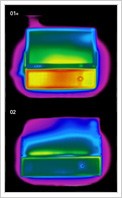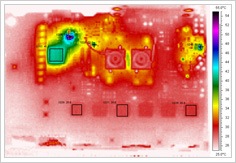IR THERMAL CHARACTERIZATION

Thermal Characterization and Analysis Service
As the electronics industry develops smaller, faster and higher power devices, thermal management becomes increasingly important. If thermal considerations are not managed carefully then high density, high performance designs will come at a cost. Higher component and ambient temperatures are known to lower reliability.
Placing devices closer together on smaller boards helps lower system size, cost and improves electrical performance. From a thermal perspective, however, raising power while reducing size can jeopardize system reliability.
Thermography
Thermography allows you to visualize the thermal behavior of printed circuit boards. Thermography provides simultaneous, non-contact measurement of temperature at tens of thousands of locations on the board.
Thermal imaging hardware and software is able to convert self-emitted infrared radiation (IR) from electronic devices into accurate temperature measurements. Self-emitting radiation is a property of all objects above absolute zero and does not need to be induced externally.
Thermal imaging fault isolation techniques employed by Reliant Labs provide a comprehensive thermal analysis on your product. Unlike thermocouples, IR Thermography scans over 1.2 million non-contact measurements per second on your PCB. Why make conclusions about your product using only a handful of thermocouples?
Applications
• Thermography quickly evaluates your product for hot spots.
• Fault isolation before and after HALT and HASS testing.
• Thermal characterization and engineering assessment.
• Power on and sequence thermal analysis.
• Verification of thermal design requirements.
• Yield improvement through location of persistent defects.
